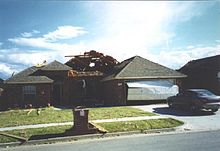User:Jer10 95/EF scale
| EFU | Unknown | No surveyable damage |
|---|---|---|
| EF0 | 65–85 mph | Light damage |
| EF1 | 86–110 mph | Moderate damage |
| EF2 | 111–135 mph | Considerable damage |
| EF3 | 136–165 mph | Severe damage |
| EF4 | 166–200 mph | Devastating damage |
| EF5 | >200 mph | Incredible damage |
The Enhanced Fujita Scale, or EF Scale, is the scale for rating the strength of tornadoes in the United States. Implemented in place of the now-obselete Fujita scale, it was used starting February 1, 2007. The scale has the same basic design as the original Fujita scale, with 6 categories representing increasing degrees of damage. It was revised to reflect better examinations of tornado damage surveys, so as to align wind speeds more closely with associated storm damage. The new scale was publicly unveiled at a conference by the American Meteorological Society in Atlanta on February 2, 2006.
Parameters
[edit]The six categories for the EF Scale are listed below, in order of increasing intensity.
| Category EF0 | Wind speed | 65–85 mph | 105–137 km/h | |
| Potential damage |  Peels surface off some roofs; some damage to gutters or siding; branches broken off trees; shallow-rooted trees pushed over. | |||
| Category EF1 | Wind speed | 86–110 mph | 138–179 km/h | |
| Potential damage |  Roofs severely stripped; mobile homes overturned or badly damaged; loss of exterior doors; windows and other glass broken. | |||
| Category EF2 | Wind speed | 111–135 mph | 180–217 km/h | |
| Potential damage |  Roofs torn off well-constructed houses; foundations of frame homes shifted; mobile homes completely destroyed; large trees snapped or uprooted; light-object missiles generated; cars lifted off ground. | |||
| Category EF3 | Wind speed | 136–165 mph | 218–266 km/h | |
| Potential damage |  Entire stories of well-constructed houses destroyed; severe damage to large buildings such as shopping malls; trains overturned; trees debarked; heavy cars lifted off the ground and thrown; structures with weak foundations blown away some distance. | |||
| Category EF4 | Wind speed | 166–200 mph | 267–324 km/h | |
| Potential damage |  Well-constructed houses and whole frame houses completely leveled; cars thrown and small missiles generated. | |||
| Category EF5 | Wind speed | >200 mph | >324 km/h | |
| Potential damage | Incredible damage.
Strong frame houses leveled off foundations and swept away; automobile-sized missiles fly through the air in excess of 100 m (109 yd); high-rise buildings have significant structural deformation; incredible phenomena will occur. (No EF5 tornadoes have yet been recorded, so no damage picture is available) | |||
Differences from the Fujita scale
[edit]The new scale takes into account how most structures are designed. The wind speeds on the original scale were deemed by meteorologists as being too large and engineering studies have shown that slower winds can cause the same damage as that of winds of 300 mph. The new scale lists an EF-5 as a tornado with winds at or above 200 mph (324 km/h), thought to be a much more accurate representation of the surface wind speeds in the most violent tornadoes. None of the tornadoes recorded on or before January 31, 2007 will be re-categorized.
Essentially, there is no functional difference in how tornadoes are rated. The old ratings and new ratings are cleanly connected with a linear formula. The only differences are adjusted wind speeds, measurements of which weren't used in previous ratings, and refined damage descriptors, to make it easier to rate tornadoes which strike few structures. Twenty-eight Damage Indicators (DI), with descriptions such as "Double-wide mobile home" or "Strip mall". with Degrees of Damage (DOD) to determine wind estimates. Different structures, depending on their building materials and ability to survive high winds, will have their own DIs and DODs.
Since the new system will still use actual tornado damage to estimate the storm's wind speed, the National Weather Service states that the new scale will likely not lead to an increase in a number of tornadoes classified as EF5 (the lower wind speed ranges have been adjusted as better estimates of what is needed to incur the damage). The upper bound of the wind speed range for EF5 is open — in other words, there is no maximum wind speed designated.
See also
[edit]- Fujita scale
- TORRO scale
- Beaufort scale
- Saffir-Simpson Hurricane Scale
- List of tornadoes and tornado outbreaks
- List of F5 tornadoes
- Severe weather terminology
References
[edit]
External links
[edit]- NOAA National Weather Service Improves Tornado Rating System (NOAA News)
- Enhanced F Scale for Tornado Damage (NOAA / SPC)
- The Enhanced Fujita Scale (EF Scale) {NOAA / SPC)
- Fujita Scale Enhancement Project (Wind Science Engineering & Research Center at Texas Tech University)
- Mitigation Assessment Team Report: Midwest Tornadoes of May 3, 1999 (FEMA)
- A Guide to F-Scale Damage Assessment (NWS)
- A Guide for Conducting Convective Windstorm Surveys (NWS SR146)
- The Tornado: An Engineering-Oriented Perspective (NWS SR147)
- Map showing severe tornadoes in Germany
- The Fujita Scale of Tornado Intensity
